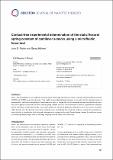Files in this item
Contact-free experimental determination of the static flexural spring constant of cantilever sensors using a microfluidic force tool
Item metadata
| dc.contributor.author | Parkin, John David | |
| dc.contributor.author | Hähner, Georg | |
| dc.date.accessioned | 2016-04-01T12:00:09Z | |
| dc.date.available | 2016-04-01T12:00:09Z | |
| dc.date.issued | 2016-03-30 | |
| dc.identifier | 241610319 | |
| dc.identifier | e2ab2804-35a0-417f-a443-56c83c22fbea | |
| dc.identifier | 84994060573 | |
| dc.identifier | 000373555600001 | |
| dc.identifier.citation | Parkin , J D & Hähner , G 2016 , ' Contact-free experimental determination of the static flexural spring constant of cantilever sensors using a microfluidic force tool ' , Beilstein Journal of Nanotechnology , vol. 7 , pp. 492-500 . https://doi.org/10.3762/bjnano.7.43 | en |
| dc.identifier.issn | 2190-4286 | |
| dc.identifier.other | ORCID: /0000-0002-6765-344X/work/60426721 | |
| dc.identifier.uri | https://hdl.handle.net/10023/8536 | |
| dc.description | Financial support from the EPSRC (EP/K000411/1 and EP/L017008/1) and the University of St. Andrews under an Impact Acceleration Account (EP/K503940/1) are gratefully acknowledged. | en |
| dc.description.abstract | Micro- and nanocantilevers are employed in atomic force microscopy (AFM) and in micro- and nanoelectromechanical systems (MEMS and NEMS) as sensing elements. They enable nanomechanical measurements, are essential for the characterization of nanomaterials, and form an integral part of many nanoscale devices. Despite the fact that numerous methods described in the literature can be applied to determine the static flexural spring constant of micro- and nanocantilever sensors, experimental techniques that do not require contact between the sensor and a surface at some point during the calibration process are still the exception rather than the rule. We describe a noncontact method using a microfluidic force tool that produces accurate forces and demonstrate that this, in combination with a thermal noise spectrum, can provide the static flexural spring constant for cantilever sensors of different geometric shapes over a wide range of spring constant values (≈0.8–160 N/m). | |
| dc.format.extent | 3104904 | |
| dc.language.iso | eng | |
| dc.relation.ispartof | Beilstein Journal of Nanotechnology | en |
| dc.subject | AFM | en |
| dc.subject | Cantilever sensors | en |
| dc.subject | Microfluidic force tool | en |
| dc.subject | Spring constant | en |
| dc.subject | QD Chemistry | en |
| dc.subject | DAS | en |
| dc.subject.lcc | QD | en |
| dc.title | Contact-free experimental determination of the static flexural spring constant of cantilever sensors using a microfluidic force tool | en |
| dc.type | Journal article | en |
| dc.contributor.sponsor | EPSRC | en |
| dc.contributor.sponsor | EPSRC | en |
| dc.contributor.sponsor | EPSRC | en |
| dc.contributor.institution | University of St Andrews. School of Chemistry | en |
| dc.contributor.institution | University of St Andrews. EaSTCHEM | en |
| dc.identifier.doi | https://doi.org/10.3762/bjnano.7.43 | |
| dc.description.status | Peer reviewed | en |
| dc.identifier.url | http://www.beilstein-journals.org/bjnano/single/downloadSuppInfo.htm?publicId=2190-4286-7-43 | en |
| dc.identifier.grantnumber | ep/k000411/1 | en |
| dc.identifier.grantnumber | EP/K503940/1 | en |
| dc.identifier.grantnumber | EP/K031252/1 | en |
This item appears in the following Collection(s)
Items in the St Andrews Research Repository are protected by copyright, with all rights reserved, unless otherwise indicated.

